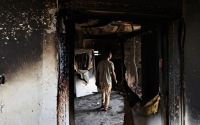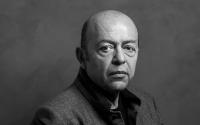27 January 2006PalestineChronicle.comRamzy Baroud
Yesterday, Palestinian voters flocked to polling stations across the Occupied Territories to elect their representatives in the Palestinian Legislative Council (Parliament). The vote is historic by every definition, not just because it demarcates another milestone of democracy for Palestinians and the region at large, but most significantly because of its potential striking outcome. This is the PLC's second election ever. The first was held in 1996 and was then understood as a culmination of the political setup introduced by the Oslo Accords and the so-called peace process. Then, many Palestinian factions opposed the vote, interpreting it for what in fact it was meant to represent: a part of the process of consolidation of the Palestinian leadership and the legitimization of the Oslo Accords it helped bring about. The outcome was then most predictable, as late Palestinian leader Yasser Arafat's Fatah Party dominated the parliament, the cabinet, thus the Palestinian Authority. Despite reluctant invitations to join the political process, most Palestinian groups rejected on the grounds that joining the PA is retrospectively validating Oslo, the Israeli occupation and the failed ways of the Palestinian leadership. Much has changed since then, however. The eruption of the Intifada in September 2000 and Israel's brutal crackdowns and reinvading of most West Bank population centers, coupled with the insistence on marginalizing the PA, the destruction of its offices and the assassination or imprisonment of its defiant elements, has widened the rift between the public and the hope they once pinned on the now fraudulent peace process. The already existent rift in the largest PLO party, Fatah also widened. A segment of the movement supported armed resistance against Israel (as exemplified in the establishment of Al-Aqsa Martyrs Brigade) and the other — seen as the pro-Israeli and US camp — favored unconditional talks with Israel and further compromises. The death of Arafat in November 2004 created a power vacuum that further highlighted the Fatah turmoil, giving it a new manifestation — that of the Old vs. the Young guard. Violence and mayhem soon followed, accompanied by irresponsible kidnappings and wanton killings in Gaza. That display, which President Mahmoud Abbas seemed incapable of containing introduced Fatah in its most chaotic stages, tarnishing its history and tainting it current image. Hamas, on the other hand, although seen as a pariah and branded terrorist by the US, Israel and most Western countries, was charming ordinary Palestinians with its discipline, continued involvement in a myriad of social and educational programs, in addition to its direct engagement in resistance against Israeli forces. It was rather ironic that as embattled Abbas failed to control his party's militants, it was Hamas members who were actively involved in trying to free the foreign hostages kidnapped in Gaza, consistently calling for an end to aimless militancy and internal fighting. Palestinians on the street, again, were taking notice of the growing divergence in Fatah and Hamas' adherence to what many Palestinians believe to be their national constants. By participating in various rounds of municipal elections, Hamas was trying to assert itself as a force to be reckoned with, not as a military force, but rather as a political one. Cleverly, the group managed to translate its growing support to an impressive show in those elections. But more has happened since then. In the last year of Al-Aqsa Intifada, there seemed to be a serious Israeli interest in eliminating Hamas. The Israeli government was under the false impression that Hamas, like any other militant organization, consists of various levels of leadership. By eliminating the top and middle echelons, the movement would certainly implode and give way to fragmentation and disorder. Hamas, for certain reasons that I wish to elaborate on in future articles, possessed a unique structure that allowed the movement to carry on despite the assassination of most of its leaders, including its spiritual leader Sheikh Ahmed Yassin. To the contrary, one can argue that the more pressure Israel and the US placed on the movement, the greater support it harnessed among Palestinians. Reasons for this logic are of course obvious, Israel being an occupying power and the US being its international beneficiary. However, Hamas also understood well that the Palestinian uprising was growing weary after years of ruthless Israeli onslaughts, growing poverty, and internal corruption. To survive in its relevance and to withstand PA and Israeli pressures, the Islamic movement felt it was necessary to translate its wide support into political representation, and if necessary perhaps get engaged in talks, according to its own priorities and values. Not that Hamas approached elections without battling its own dilemmas: how can one engage in a political process and reject the platform that made such process possible (i.e. Oslo)? How far is Hamas willing to go to maintain its new image while convincing its supporters that it still is committed to resistance against the Israeli occupation? But the Palestinian elections pose greater dilemmas to the PA, Israel, the United States, and even Europe and various Arab states. Each party is now pondering the possibility of a Hamas win or at least visible and strong Hamas participation in the Palestinian political system. How can these parties approach the already thorny issue with Hamas on board? This remains a difficult to answer question. In the final analysis, however, the decision of the Palestinian people must be respected regardless of the outcome, and for once, those involved need to appreciate the workings of a real democratic process, rather than trying to tailor democracy to suit their own interests. The Palestinian vote is indeed historic. Its possible outcome can change the rules of the game for years to come. -Ramzy Baroud is an Arab American journalist who teaches mass communication at Curtin University of Technology. His forthcoming book is The Second Palestinian Intifada: A Chronicle of a People's Struggle, which can be pre-ordered through Amazon.com. He is the Editor-in-Chief of PalestineChronicle.com






